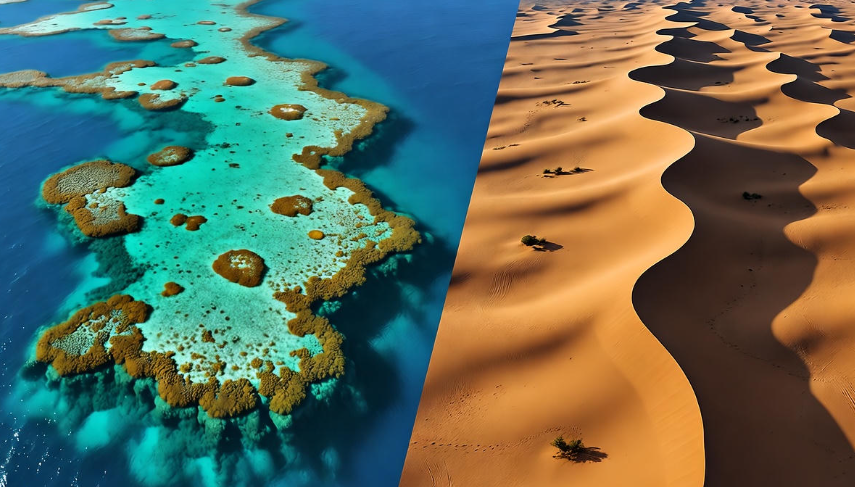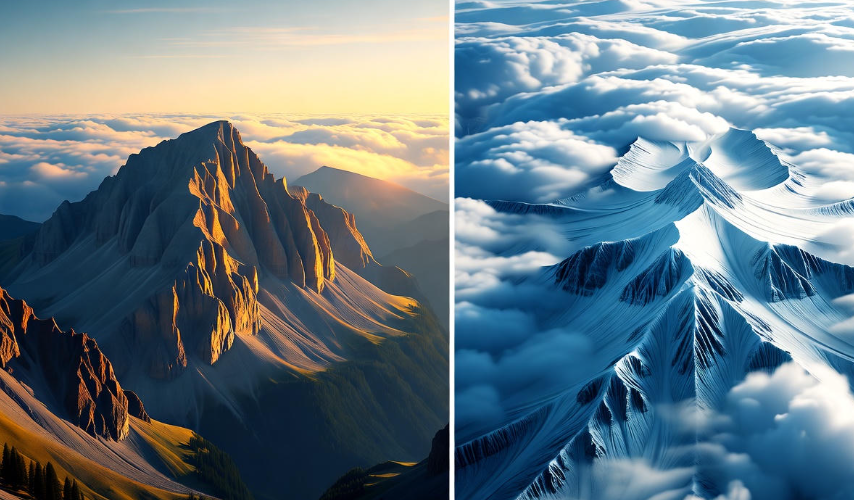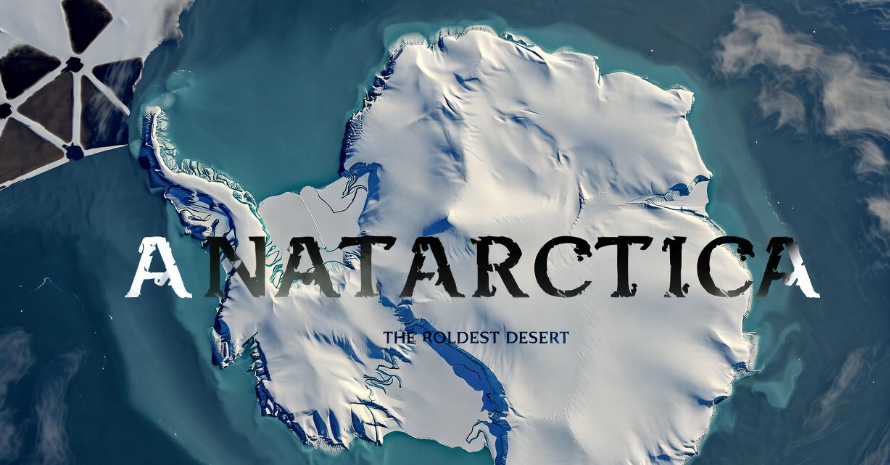Have you ever looked up at the sky and wondered what Earth looks like from above? Astronauts often say that seeing our planet from space changes the way they feel about life itself. It’s not just blue oceans and white clouds—our world is filled with jaw-dropping natural wonders that can actually be seen from space.
From swirling deserts to colorful coral reefs, these natural creations are so big and beautiful that even satellites can capture them. Let’s take a closer look at some of the most amazing natural wonders you can see from space.
The Great Barrier Reef, Australia
One of the most stunning natural sights from space is the Great Barrier Reef. Stretching over 2,300 kilometers, this massive reef system is the largest living structure on Earth. It’s made up of more than 2,900 individual reefs and 900 islands.
When astronauts orbit above Australia, they often say it’s like seeing a shimmering necklace in the ocean. The bright blue and turquoise colors pop out against the deep navy water — it’s breathtaking.
Unfortunately, the reef is facing threats from coral bleaching and climate change, but from space, it still remains a glowing gem of our planet.
| Feature | Details |
|---|---|
| Location | Queensland, Australia |
| Length | 2,300 km |
| Visible From Space | Yes (very clear) |
| Interesting Fact | It’s the largest living thing on Earth and can be seen from orbit! |
The Amazon Rainforest, South America
The Amazon is so huge that it’s often called the “lungs of the Earth.” From space, it looks like a giant green ocean stretching across nine countries — mostly Brazil.
Satellites capture its thick, emerald canopy that changes shades depending on the season. Rivers like the Amazon River snake through it like silver ribbons, shining under sunlight.
But here’s something interesting: astronauts say they can even spot smoke from forest fires in the dry season. That’s both fascinating and a little sad, right? The Amazon’s beauty and importance to life on Earth make it one of the most remarkable sights visible from space.
The Sahara Desert, Africa ️
The Sahara is the world’s largest hot desert — and yes, you can see it easily from space! Its golden and orange sands stretch across 11 countries and cover nearly the same area as the United States.
From above, the Sahara looks like a swirling sea of dunes, rock formations, and dry riverbeds. The patterns shift constantly as winds move the sands, giving the desert a living, moving appearance.
Astronauts often describe it as “a golden blanket over Africa.” Isn’t that poetic?
| Sahara Facts | Numbers |
|---|---|
| Area | ~9.2 million sq km |
| Countries Covered | 11 |
| Seen From Space | Very clearly |
| Fun Fact | The temperature can drop below freezing at night! |
The Himalayas and Mount Everest ️
When you think of the tallest mountain on Earth, Mount Everest comes to mind — but what’s truly amazing is that even from space, this entire mountain range stands out like a giant wrinkle on the planet.
The Himalayas stretch for over 2,400 kilometers across five countries, including Nepal, India, Bhutan, China, and Pakistan. The snow-capped peaks glisten in the sunlight, creating a sharp contrast with the green valleys below.
From space, the Himalayas appear as a bright white line that separates India from Tibet. And during sunrise, the peaks catch the first light before anywhere else — visible even from the International Space Station!
The Grand Canyon, USA
You probably know the Grand Canyon as one of the most popular tourist destinations in the world. But did you know that it’s also visible from space?
Cut deep by the Colorado River, this giant scar in the Earth’s crust stretches for 446 kilometers. The layers of red, orange, and brown rock tell stories that go back millions of years.
From above, it looks like a deep crack running through the desert. Astronauts often say it’s one of the easiest landmarks to recognize from orbit because of its unique shape and color.
The Great Wall of China (and Why It’s Often Misunderstood)
There’s a popular myth that the Great Wall of China is the only man-made structure visible from space. That’s not entirely true — it’s actually quite difficult to see with the naked eye because it blends in with the landscape.
However, the interesting part is that while the wall itself may not be easy to spot, the regions around it — deserts, mountains, and plains — create visible patterns that can be seen from orbit.
So, while it’s not a natural wonder, the landscape surrounding it is breathtaking when viewed from above.
The Ganges River Delta, Bangladesh and India
The Ganges Delta is the world’s largest river delta, and it’s absolutely stunning from space. It fans out into the Bay of Bengal, forming a beautiful green-and-blue pattern.
From above, the delta looks like a living painting — full of channels and waterways that constantly change with tides and floods. This region is also one of the most fertile lands on Earth, supporting millions of people.
Interestingly, satellites help scientists monitor floods and changes in the delta every year. It’s both beautiful and scientifically important.
-
Also read: Why Old Maps Are Inaccurate Yet Beautiful
The Aurora Borealis (Northern Lights)
Few natural sights are as magical as the Northern Lights, and astronauts have the best seat in the universe to see them.
From the International Space Station, the auroras appear as dancing curtains of green, purple, and red light flowing over the poles. They happen when particles from the Sun collide with Earth’s atmosphere — creating one of nature’s greatest light shows.
Even though they’re technically in the sky and not on the ground, they’re still counted as one of the most breathtaking natural wonders visible from space.
| Aurora Facts | Description |
|---|---|
| Where Seen | Near Earth’s poles |
| Colors | Green, pink, purple, red |
| Seen From Space? | Yes, very bright |
| Cause | Solar particles hitting Earth’s atmosphere |
The Eye of the Sahara (Richat Structure), Mauritania ️
One of the most mysterious features on Earth, the Eye of the Sahara is a circular geological formation in the middle of the desert.
It looks exactly like a giant eye staring up at the sky — about 40 kilometers wide!
Astronauts use it as a visual marker to locate the Sahara Desert because it’s so distinctive. Scientists believe it was formed by erosion, not an asteroid impact as once thought. Still, it’s hard to believe something that perfectly round happened naturally.
From space, it almost feels like the planet itself is looking back at you. ️
The Great Blue Hole, Belize
The Great Blue Hole is one of the most stunning underwater sinkholes in the world, located near the coast of Belize.
From above, it looks like a perfect dark-blue circle surrounded by lighter turquoise water — a striking image that astronauts love to photograph. It’s about 300 meters wide and 125 meters deep, and divers describe it as one of the most surreal experiences on Earth.
Even from orbit, its beauty is undeniable. It’s one of those rare spots that looks even more mysterious the higher you go.
Lake Baikal, Russia ❄️
Lake Baikal in Siberia isn’t just the oldest freshwater lake — it’s also the deepest and holds about 20% of all the world’s unfrozen freshwater.
From space, it looks like a long, curved crack filled with deep blue water. During winter, it freezes over completely, creating beautiful white ice patterns that satellites capture in amazing detail.
It’s sometimes called “the Pearl of Siberia,” and from orbit, it truly shines like one.
The Nile River, Egypt
When night falls on Earth, one of the most visible features from space is the Nile River glowing through the darkness.
Why glowing? Because cities and towns along the Nile light up like a sparkling thread running through the desert. The contrast between the dark Sahara and the bright river is so sharp that even astronauts say it’s one of the most beautiful night views on Earth.
It’s not just a natural wonder — it’s also a reminder of how human life thrives around nature’s gifts.
The Grand Prismatic Spring, USA
In Yellowstone National Park, there’s a hot spring so colorful it looks unreal. The Grand Prismatic Spring is the largest hot spring in the United States, and its colors — blue, green, yellow, and red — are caused by different heat-loving bacteria.
From space, this rainbow-colored circle stands out beautifully against the earthy landscape. It’s like nature’s own art piece, visible even from far above.
Summary Table: Natural Wonders Visible From Space
| Natural Wonder | Location | Type | Seen From Space | Unique Feature |
|---|---|---|---|---|
| Great Barrier Reef | Australia | Marine | ✅ Yes | Largest living structure |
| Amazon Rainforest | South America | Forest | ✅ Yes | “Lungs of the Earth” |
| Sahara Desert | Africa | Desert | ✅ Yes | Golden dunes visible from orbit |
| Himalayas | Asia | Mountain range | ✅ Yes | Home to Mount Everest |
| Grand Canyon | USA | Canyon | ✅ Yes | Deep red layered cliffs |
| Eye of the Sahara | Mauritania | Geological | ✅ Yes | Circular “eye” formation |
| Great Blue Hole | Belize | Marine sinkhole | ✅ Yes | Perfect circular hole |
| Aurora Borealis | Polar Regions | Atmospheric | ✅ Yes | Dancing lights from space |

Why These Sights Matter
Seeing these wonders from space reminds us how fragile and interconnected our world really is. Every color, shape, and pattern tells a story — of water, life, time, and change.
It’s also a strong reminder that we share just one planet. The view from space shows no borders, no countries — just one beautiful Earth.
Frequently Asked Questions (FAQs)
Q1: Can astronauts really see these places with their eyes, or only through cameras?
Astronauts can see many of these wonders with their own eyes, especially large ones like the Sahara Desert, Himalayas, and the Great Barrier Reef. Cameras and satellite images help capture even more details.
Q2: Is it true that the Great Wall of China is visible from space?
Not exactly. It’s hard to see with the naked eye because it blends with the land, but satellite photos can detect it using special imaging.
Q3: Can city lights be seen from space too?
Yes! At night, astronauts can see bright city lights — especially places like Las Vegas, Tokyo, and the Nile River area.
Q4: What’s the most colorful natural wonder from space?
The Grand Prismatic Spring and the Great Barrier Reef are probably the most colorful due to their vivid natural pigments.
Q5: Which natural wonder changes the most over time?
The Amazon Rainforest and Ganges Delta change the most due to weather, seasons, and human activity. They look slightly different in satellite images every year!
Final Thoughts
The view of Earth from space is a breathtaking reminder of how incredible nature can be. These wonders — deserts, oceans, forests, and lights — all tell the story of a planet full of life and color.
If you ever feel small, just remember — even from thousands of kilometers away, Earth’s beauty still shines.




